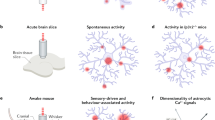Abstract
A large body of evidence indicates that astrocytes play an important role in a range of brain functions through calcium (Ca2+) signaling. Experimentally evoking Ca2+ signaling is a useful technique for investigating the functions of astrocytes. However, conventional stimulation methods typically have poor spatio-temporal precision, and some are invasive. Our group has developed a technique to overcome these problems, in which astrocytes are photostimulated with a femtosecond laser. In the current study, we applied this method to a hippocampal neural network to explore astrocytic functions in detail. The results revealed that applying photostimulation to astrocytes in a cultured hippocampal astrocyte-neuron network caused the following changes: (i) Synchronous Ca2+ oscillations in neurons were induced; (ii) spontaneous Ca2+ synchrony instantaneously emerged; and (iii) high-frequency spontaneous Ca2+ synchrony was regulated. Thus, astrocytic Ca2+ signaling evoked by photostimulation was found to modulate synchronous Ca2+ oscillations in hippocampal neurons. We propose that photostimulation with a femtosecond laser will serve as a powerful tool in investigating astrocytic functions at the network level.
Similar content being viewed by others
References
Carmignoto G. Reciprocal communication systems between astrocytes and neurones. Prog Neurobiol, 2000, 62: 561–581
Haydon P G, Carmignoto G. Astrocyte control of synaptic transmission and neurovascular coupling. Physiol Rev, 2006, 86: 1009–1031
Nedergaard M, Ransom B, Goldman S A. New roles for astrocytes: Redefining the functional architecture of the brain. Trends Neurosci, 2003, 26: 523–530
Schummers J, Yu H, Sur M. Tuned responses of astrocytes and their influence on hemodynamic signals in the visual cortex. Science, 2008, 320: 1638–1643
Volterra A, Meldolesi J. Astrocytes, from brain glue to communication elements: the revolution continues. Nat Rev Neurosci, 2005, 6: 626–640
Porter J T, McCarthy K D. Astrocytic neurotransmitter receptors in situ and in vivo. Prog Neurobiol, 1997, 51: 439–455
Verkhratsky A, Orkand R K, Kettenmann H. Glial calcium: Homeostasis and signaling function. Physol Rev, 1998, 78: 99–141
Zhang Z, Chen G, Zhou W, et al. Regulated ATP release from astrocytes through lysosome exocytosis. Nat Cell Biol, 2007, 9: 945–953
Jourdain P, Bergersen L H, Bhaukaurally K, et al. Glutamate exocytosis from astrocytes controls synaptic strength. Nat Neusci, 2007, 10: 331–339
Mothet J-P, Pollegioni L, Ouanounou G, et al. Glutamate receptor activation triggers a calcium-dependent and SNARE protein-dependent release of the gliotransmitter D-serine. Proc Natl Acad Sci USA, 2005, 102: 5606–5611
Charles A C, Merrill J E, Dirksen E R, et al. Intercellular signaling in glial cells: calcium waves and oscillations in response to mechanical stimulation and glutamate. Neuron, 1991, 6: 983–992
Bernardinelli Y, Magistretti P J, Chatton J Y. Astrocytes generate Na+-mediated metabolic waves. Proc Natl Acad Sci USA, 2004, 101: 14937–14942
Nedergaard M. Direct signaling from astrocytes to neurons in cultures of mammalian brain cells. Science, 1994, 263: 1768–1771
Fiacco T A, McCarthy K D. Intracellular astrocyte calcium waves in situ increase the frequency of spontaneous AMPA receptor currents in CA1 pyramidal neurons. J Neurosci, 2004, 24: 722–732
Leybaert L, Paemeleire K, Strahonja A, et al. Inositol-trisphosphate-dependent intercellular calcium signaling in and between astrocytes and endothelial cells. Glia, 1998, 24: 398–407
Zhao Y, Zhang Y, Liu X, et al. Photostimulation of astrocytes with femtosecond laser pulses. Opt Express, 2009, 17: 1291–1298
Vogel A, Noack J, Huttman G, et al. Mechanisms of femtosecond laser nanosurgery of cells and tissues. Appl Phys B, 2005, 81: 1015–1047
Vogel A, Venugopalan V. Mechanisms of pulsed laser ablation of biological tissues. Chem Rev, 2003, 103: 577–644
Tirlapur U K, König K. Femtosecond near-infrared laser pulses as a versatile non-invasive tool for intra-tissue nanoprocessing in plants without compromising viability. The Plant J, 2002, 31: 365–374
Watanabe W, Matsunaga S, Fukui K, et al. Intracellular manipulation by femtosecond lasers: Review. J Innov Opt Health Sci, 2009, 2: 1–8
Yanik M F, Cinar H, Cinar H N, et al. Functional regeneration after laser axotomy. Nature, 2004, 432: 822–822
Zhou W, Liu X, Lv X, et al. Monitor and control of neuronal activities with femtosecond pulse laser. Chinese Sci Bull, 2008, 53: 687–694
Gong J, Zhao X, Xing Q, et al. Femtosecond laser-induced cell fusion. Appl Phys Lett, 2008, 92: 093901
Tirlapur U K, König K. Targeted transfection by femtosecond laser. Nature, 2002, 418: 290–291
König K, Riemann I, Fritzsche W. Nanodissection of human chromosomes with near-infrared femtosecond laser pulses. Opt Lett, 2001, 26: 819–821
Liu X, Lv X, Zeng S, et al. Noncontact and nondestructive identification of neural circuits with a femtosecond laser. Appl Phys Lett, 2009, 94: 061113
Chen W, Li X, Pu J, et al. Nonlinear characteristics in the spontaneous activities of cultured neuronal networks (in Chinese). Chinese Sci Bull, 2010, 55: 7–14
Lau P, Bi G. Reverberatory activity in neuronal networks in vitro. Chinese Sci Bull, 2009, 54: 1828–1835
Corlew R, Bosma M M, Moody W J. Spontaneous, synchronous electrical activity in neonatal mouse cortical neurones. J Physiol, 2004, 560: 377–390
Engel A K, Fries P, Singer W. Dynamic predictions: Oscillations and synchrony in top-down processing. Nat Rev Neurosci, 2001, 2: 704–716
Schnitzler A, Gross J. Normal and pathological oscillatory communication in the brain. Nat Rev Neurosci, 2005, 6: 285–296
Fellin T, Pascual O, Gobbo S, et al. Neuronal synchrony mediated by astrocytic glutamate through activation of extrasynaptic NMDA receptors. Neuron, 2004, 43: 729–743
Author information
Authors and Affiliations
Corresponding author
About this article
Cite this article
Zhao, Y., Liu, X., Zhang, Y. et al. Modulation of synchronous calcium oscillations in hippocampal neurons by photostimulation of astrocytes with femtosecond laser. Chin. Sci. Bull. 55, 3436–3440 (2010). https://doi.org/10.1007/s11434-010-3376-z
Received:
Accepted:
Published:
Issue Date:
DOI: https://doi.org/10.1007/s11434-010-3376-z




